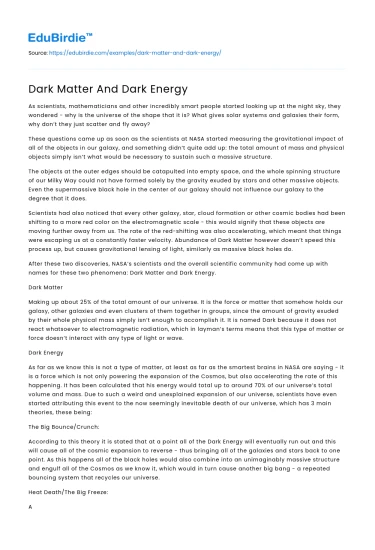As scientists, mathematicians and other incredibly smart people started looking up at the night sky, they wondered - why is the universe of the shape that it is? What gives solar systems and galaxies their form, why don’t they just scatter and fly away?
These questions came up as soon as the scientists at NASA started measuring the gravitational impact of all of the objects in our galaxy, and something didn’t quite add up: the total amount of mass and physical objects simply isn’t what would be necessary to sustain such a massive structure.
Save your time!
We can take care of your essay
- Proper editing and formatting
- Free revision, title page, and bibliography
- Flexible prices and money-back guarantee
The objects at the outer edges should be catapulted into empty space, and the whole spinning structure of our Milky Way could not have formed solely by the gravity exuded by stars and other massive objects. Even the supermassive black hole in the center of our galaxy should not influence our galaxy to the degree that it does.
Scientists had also noticed that every other galaxy, star, cloud formation or other cosmic bodies had been shifting to a more red color on the electromagnetic scale - this would signify that these objects are moving further away from us. The rate of the red-shifting was also accelerating, which meant that things were escaping us at a constantly faster velocity. Abundance of Dark Matter however doesn’t speed this process up, but causes gravitational lensing of light, similarly as massive black holes do.
After these two discoveries, NASA’s scientists and the overall scientific community had come up with names for these two phenomena: Dark Matter and Dark Energy.
Dark Matter
Making up about 25% of the total amount of our universe. It is the force or matter that somehow holds our galaxy, other galaxies and even clusters of them together in groups, since the amount of gravity exuded by their whole physical mass simply isn’t enough to accomplish it. It is named Dark because it does not react whatsoever to electromagnetic radiation, which in layman’s terms means that this type of matter or force doesn’t interact with any type of light or wave.
Dark Energy
As far as we know this is not a type of matter, at least as far as the smartest brains in NASA are saying - it is a force which is not only powering the expansion of the Cosmos, but also accelerating the rate of this happening. It has been calculated that his energy would total up to around 70% of our universe’s total volume and mass. Due to such a weird and unexplained expansion of our universe, scientists have even started attributing this event to the now seemingly inevitable death of our universe, which has 3 main theories, these being:
The Big Bounce/Crunch:
According to this theory it is stated that at a point all of the Dark Energy will eventually run out and this will cause all of the cosmic expansion to reverse - thus bringing all of the galaxies and stars back to one point. As this happens all of the black holes would also combine into an unimaginably massive structure and engulf all of the Cosmos as we know it, which would in turn cause another big bang - a repeated bouncing system that recycles our universe.
Heat Death/The Big Freeze:
A sadder and more fatalistic theory. It states that since the rate of the universal expansion isn’t explained, we do not know what its limits would be, so if it approached light speed - it would mean that we would never see any other solar systems, even less galaxies through space exploration, and eventually the distances would be too great even for light to travel. If this happens all objects will use up their thermal energy until they eventually freeze and all of our universe becomes dark.
Neverending Expansion:
A very scary idea, that if the acceleration of our universe surpasses the speed of light - not even atoms would be able to form anymore, since empty space would constantly be created between and around them, thus turning our universe into a chaotic soup of non-interactive particles that just float around for eternity.
Recent advancements have been made and a particle has been discovered that has similar qualities to the mythical Dark Matter - axions. These are quarks with six fundamental particles instead of the typical three found in most of our normal atoms. These constructs are much lighter than a photon, thus making them extremely difficult to detect, however with advancements in quantum computers and quantum research - scientists have validated the existence of this particle.






 Stuck on your essay?
Stuck on your essay?

